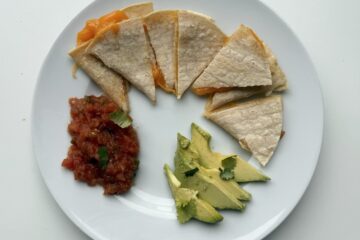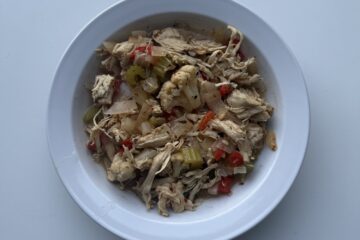20 Foods and Ingredients You Didn’t Know Aren’t Gluten-Free (And How to Substitute)
One of the biggest struggles when I first started my gluten-free journey was finding out the hard way what wasn’t gluten-free. When I stopped eating gluten and my tolerance for gluten went down (a lot), I had Benadryl on hand allllll the time.
After a few bottles of Benadryl (I’m serious I did not learn my lesson for a long time), I started researching things that had gluten in it, and some items really surprised me. I did not have a terrible enough reaction to need Benadryl every time, but after learning about some items on this list, my constant stomach aches made a lot more sense.
If you’re living gluten-free, you probably know the basics like wheat, barley, and rye are a few things that you can’t eat anymore. But sometimes it’s the stuff that seems safe that can trip you up. A lot of processed foods have sneaky sources of gluten, and it’s not always obvious. Whether you’ve been gluten-free for a while or you’re just starting, here are 20 ingredients you might not realize contain gluten, plus some simple swaps to keep your meals on track.
- Soy Sauce
Most soy sauces are made with wheat, so they’re not gluten-free.
Substitute: Try tamari (a gluten-free soy sauce), or go for coconut aminos for a slightly sweeter, soy-free option.
- Oats
Oats are naturally gluten-free, but they’re often processed in facilities that handle wheat, leading to cross-contamination.
Substitute: Look for certified gluten-free oats, which are processed in dedicated gluten-free facilities to avoid cross-contamination.
- Rice Mixes
Many packaged rice mixes contain wheat-based seasonings or flavorings.
Substitute: Instead of pre-packaged mixes, use plain rice and create your own seasoning with herbs, spices, or gluten-free stock. You could also try quinoa or millet for a fun alternative.
- Processed Meats (like Sausages and Hot Dogs)
Processed meats often contain gluten as a binder or filler.
Substitute: Choose gluten-free sausages or deli meats that are clearly labeled as gluten-free, or stick to fresh meats without added fillers.
- Salad Dressings
Many salad dressings use malt vinegar or modified food starch, both of which may contain gluten.
Substitute: Make your own with olive oil, vinegar (apple cider or distilled white vinegar), lemon juice, and herbs. You can also find pre-made gluten-free dressings at most grocery stores.
- Broths and Bouillons
Some broths and bouillons contain wheat-based thickeners.
Substitute: Opt for gluten-free broths (check the label), or make your own by simmering meat or veggies with herbs. Bone broth is a great option too!
- Seasoning Mixes
Many pre-made seasoning mixes contain modified food starch or wheat flour as fillers.
Substitute: Buy gluten-free seasoning mixes (always check the label), or make your own with single spices like cumin, paprika, garlic powder, and chili powder.
- Barbecue Sauce
Some barbecue sauces contain malt vinegar or soy sauce, both of which have gluten.
Substitute: Look for gluten-free barbecue sauces or whip up your own using tomato paste, apple cider vinegar, brown sugar, and your favorite spices.
- Imitation Crab (Surimi)
Imitation crab often contains wheat starch as a binder.
Substitute: Use real crab meat or try fish-based options like cod or pollock for a different seafood flavor.
- Ice Cream (Certain Brands)
Some ice creams contain cookie dough, malt, or gluten-based stabilizers.
Substitute: Go for gluten-free ice creams (there are plenty of options out there), or make your own using coconut milk or almond milk as the base and add fruit or gluten-free chocolate chips.
- Vinegar (Except Distilled White or Apple Cider)
Malt vinegar and some balsamic vinegars are made from barley and can contain gluten.
Substitute: Use apple cider vinegar, white distilled vinegar, or rice vinegar. For balsamic, look for one that’s labeled gluten-free.
- Energy and Granola Bars
Many energy and granola bars contain gluten or are processed in facilities with wheat products.
Substitute: Make your own gluten-free granola bars with oats, honey, dried fruit, and nuts, or grab pre-packaged options from brands like RXBAR or Kind.
- Licorice
Many licorice candies contain wheat flour as a binder.
Substitute: Look for gluten-free licorice or go for other candy options like dark chocolate or gummy bears that are gluten-free.
- Artificial Sweeteners (Maltitol or Maltodextrin)
Maltodextrin can sometimes be made from wheat, so it might contain trace amounts of gluten.
Substitute: Choose corn-derived maltodextrin (which is gluten-free) or go with stevia, monk fruit sweetener, or erythritol.
- Worcestershire Sauce
Some Worcestershire sauces use malt vinegar, which contains gluten.
Substitute: Look for gluten-free Worcestershire sauce (like Annie’s), or make your own by mixing apple cider vinegar, tamari, molasses, and spices.
- Chips (Flavored Potato Chips)
Flavored chips may use wheat starch in their seasonings.
Substitute: Opt for plain potato chips or choose gluten-free flavored chips (brands like Cape Cod or Lay’s have options), or try veggie chips for a change.
- Sushi Rolls (With Imitation Crab)
Many sushi rolls contain imitation crab (surimi), which often has wheat starch.
Substitute: Ask for rolls with real crab or go for vegetarian rolls with ingredients like avocado, cucumber, or other gluten-free fillings.
- Spirits (Whiskey, Bourbon, Scotch)
Whiskey, bourbon, and scotch are made from barley, which contains gluten.
Substitute: Choose vodka (made from potatoes or corn), rum, or tequila—all naturally gluten-free options.
- Canned Vegetables (Seasoned or Sauced)
Some canned vegetables come with seasonings that contain wheat or soy sauce.
Substitute: Go for plain canned vegetables or fresh veggies, and season them yourself with gluten-free spices or a homemade dressing.
- Pre-packaged Frozen Vegetables (With Sauces)
Some frozen veggie mixes come with sauces that may have wheat flour or gluten-based thickeners.
Substitute: Pick up plain frozen vegetables and make your own sauce using olive oil, garlic, herbs, and gluten-free stock.
Conclusion
It’s easy to assume that most natural foods are gluten-free, but a lot of processed ingredients have sneaky sources of gluten. Whether it’s from additives, flavor enhancers, or cross-contamination, gluten can sneak into your meals. The best way to avoid it is by checking labels, opting for gluten-free alternatives, and making your own seasonings or sauces when you can. With these swaps, you can keep your gluten-free lifestyle on track without missing out on flavor!
Make sure to check out my last blog: Salads That Don’t Suck, where I share my favorite salads that actually taste good!
If you want more content like this, or have any other suggestions, questions, or anything you would like to share with me, please fill out the recipe suggestions, kitchen struggles survey, or contact us forms!
Please follow us on our Facebook, Instagram, Pinterest, and subscribe to our email list! You will receive bonus recipes, insights, and extra exciting information!



